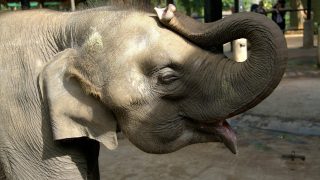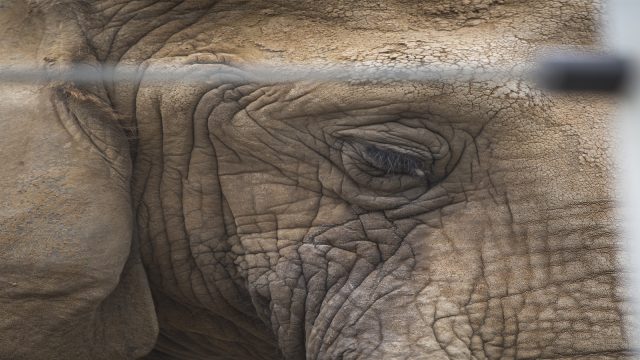
California Supreme Court Reverses Protections for Elephants Confined at Los Angeles Zoo
By Nicole Pallotta, Academic Outreach Manager
“All is not well at the Elephants of Asia exhibit at the Los Angeles Zoo. Contrary to what the zoo’s representatives may have told the Los Angeles City Council in order to get construction of the $42 million exhibit approved and funded, the elephants are not healthy, happy, and thriving.”– Los Angeles Superior Court Judge John Segal
The above is an excerpt from an opinion issued after a six-day trial in July 2012, in which Los Angeles Superior Court Judge John Segal harshly criticized the Los Angeles Zoo for its treatment of Billy, Jewel, and Tina, the three elephants in its care. Though he declined to send the elephants to a sanctuary, Judge Segal issued an injunction aimed at improving their well-being. In May 2017, the California Supreme Court unanimously overturned that injunction.
The 2012 injunction prohibited the use of “bull hooks and electric shock in the management, care, and discipline of the elephants” and required the zoo to provide at least two hours of exercise a day on soft ground to protect the animals’ feet and joints. The Animal Legal Defense Fund, along with other groups including the American Civil Liberties Union (ACLU), submitted amicus briefs in support of retaining the injunction.
The injunction was reversed on procedural grounds rather than on the merits of the case. As explained by the Los Angeles Times: “The highly technical ruling said a taxpayer lawsuit, which relies on rules of civil law, cannot be used to stop criminal conduct. The suit that led to the injunction against the zoo accused it of violating a criminal law against animal cruelty.”
The original complaint was filed in 2007 by taxpayers against the City of Los Angeles (which owns and operates the Los Angeles Zoo) and John Lewis, the zoo’s director, to enjoin what they argued was abusive, damaging and wasteful behavior by the Los Angeles Zoo regarding its Elephants of Asia exhibit.
The plaintiffs’ theory was that the city’s criminal mistreatment of the animals, particularly its violation of California Penal Code section 596.5, which specifically prohibits the abuse of elephants, amounted to an illegal and wasteful use of public funds.
The July 2012 Injunction and Opinion
In an eloquent 56-page opinion accompanying the 2012 injunction, Judge Segal agreed with the plaintiffs on major points regarding the elephants’ inadequate living conditions and roundly criticized Los Angeles Zoo officials for being “delusional” about the animals’ well-being. He singled out the senior elephant keeper in particular for having “shocking gaps in her knowledge” and “surprising misconceptions” about elephant behavior.
A central point in the trial, argued by zoo employees but corroborated by none of the elephant experts who testified, was whether the animals’ repetitive head-bobbing – a stereotypic behavior widely recognized by ethologists as an indicator of frustration, boredom, and stress in captive animals – was in fact a sign of happiness.
One of the many incorrect assertions made by the senior elephant keeper during her testimony was that this disturbing head-bobbing, which is not seen in wild elephants, is similar to a dog’s excited tail wag, a particularly preposterous assertion given the preponderance of evidence to the contrary. Judge Segal did not mince words when he called her belief an “anthropomorphic fantasy.” He also said it was “particularly disturbing” that someone with such misguided and uninformed opinions was the senior employee in charge of caring for the elephants and essentially controlling their lives in captivity.
In contrast, the court credited the testimony of Dr. Joyce Poole, a renowned elephant expert, for her extensive knowledge and experience and called her the most credible witness regarding elephant behavior. She testified that head-bobbing and other stereotypic behaviors seen in Billy, Tina, and Jewel, like swaying and rocking back and forth in place, is never seen in wild elephants as an expression of excitement or happiness, and that to the contrary these behaviors unequivocally show the zoo is not meeting the animals’ needs.
Judge Segal agreed, writing movingly about the substandard conditions these highly intelligent and sensitive animals are forced to endure:
“Thus, the Elephants of Asia exhibit at the Los Angeles Zoo is not a happy place for elephants…Captivity is a terrible existence for any intelligent, self-aware species, which the undisputed evidence shows elephants are. To believe otherwise, as some high-ranking zoo employees appear to believe, is delusional. And the quality of life that Billy, Tina, and Jewel endure in their captivity is particularly poor.”
Although he poignantly concluded that the elephants’ existence was “empty, purposeless, boring, and occasionally painful,” Judge Segal stopped short of ruling conditions at the zoo were abusive. In reaching this conclusion, he noted that section 596.5 of the penal code did not define “abusive behavior,” and that this lack of clarity made it difficult to know which behaviors were prohibited by law and what standard to use in deciding whether the zoo’s treatment of the elephants rose to the level of abusive behavior. Although agreeing that life for Billy, Tina, and Jewel at the zoo was essentially miserable, he concluded that the zoo’s conduct was not cruel beyond the “ordinary” circumstances of captivity:
“This case raises the question of whether the recreational or perhaps educational needs of one intelligent mammal species outweigh the physical and emotional, if not survival, needs of another. Existing California law does not answer that question.”
He did however, rule that the use of bullhooks (a fireplace poker-like device used to strike elephants), electric shocks, and other methods of discipline were abusive and inappropriate under penal code section 596.5. Though the zoo argued it had voluntarily stopped using these methods, the court was skeptical of this claim given the timing and manner of the stated cessation (which occurred only during litigation).
Noting that statements of the zoo director during trial did “not inspire confidence in his commitment,” Judge Segal determined the injunction was necessary to ensure compliance, since the zoo could resume these methods as soon as litigation ended.
He also found plaintiffs had met their burden to prove that the zoo was in violation of penal code section 597t, which requires confined animals have an adequate exercise area. Rather than sending the elephants to a sanctuary, which Judge Segal wrote was a “bit much,” the court’s remedy was to increase their exercise time in their current area and mandate the soil be rototilled to make it softer.
Although the ruling unfortunately did not send Billy, Tina, and Jewel to one of the two reputable sanctuaries suggested by plaintiffs, the injunction was a positive step. In light of the California Supreme Court’s reversal, advocates are now left hoping the zoo will voluntarily adhere to these provisions, which it has said it will do. The use of bullhooks to control elephants was banned in California in 2016, and the zoo has said it no longer uses electric shocks and will continue to adhere to the exercise provisions mandated by the now defunct order.
Do Elephants Belong in Zoos?
It would be difficult, if not impossible, for a captive setting to replicate an elephant’s natural habitat, in which they walk up to 18 hours a day, maintain complex social relationships, and live in extended family units. However, reputable sanctuaries do a much better job replicating natural conditions than even the most well-equipped zoo, which simply cannot provide adequate space or come close to approximating the richness and complexity of elephants’ lives in the wild.
With almost every natural instinct thwarted, and denied autonomous social interaction with other members of their species,[1] these cognitively and emotionally sophisticated animals suffer tremendously in zoos.
It is also important to note that while the historical transformation of the modern zoo has included replacing iron bars with more “naturalistic” exhibits, these changes lack substance and are more set design for the audience than meaningful improvements for the animals. Putting captive animals in more natural-looking settings is in part savvy marketing intended to assuage the unease of zoo-goers, who have become increasingly uncomfortable seeing wild animals in captivity.
Judge Segal’s opinion starkly and sadly drove this point home with regard to the exhibit in which Billy, Tina, and Jewel are on display. Although the trees give a natural impression to zoo-goers, the average visitor likely does not realize those trees are surrounded by electrical wires so the animals can’t even enjoy them or partake in natural behaviors:
“…[T]he available surface area for the elephants is much smaller than the total exhibit space because significant portions of the exhibit are closed to [them]. Elephants enjoy rubbing against and playing with trees, and like to knock them over and eat them. The trees and planters in the exhibit, however, are surrounded by electrical wires that prevent the elephants from getting to them or walking near them…[I]n fact there are no areas of grass that are not ‘hot-wired’ with electrical wires…[T]he hot wiring in the elephant exhibit is all over the exhibit and is used to protect certain areas of the exhibit from the elephants, and to keep or ‘guide’ the elephants away from things like trees, plants, and grasses.
Which makes life for the elephants in the Los Angeles Zoo even worse. It is undisputed that elephants by nature are attracted to and have evolved to need and use trees, bushes, and grass…It is one thing to place electric fencing between elephants and something they are not interested in. It is another thing to place such electric hot-wiring between the elephants and something they like, need, and use as part of their natural behavior.
Thus, rather than providing the elephants with trees to rub against and knock down as part of ‘an enriched environment that stimulates and elicits species-specific behavior’ (Exh. 72 at 4), the Los Angeles Zoo’s elephant management system tempts the elephants with trees that elephants naturally use to rub against and knock down, but frustrates the elephants by keeping those trees in visual and sensory range but beyond access behind electrically-charged wires.”
It is difficult to read this and not empathize with the frustration the elephants must feel, surrounded by trees they are punished for trying to touch. And sadly the inadequate conditions at the Los Angeles Zoo are fairly typical for large, well-established zoos, and far surpass conditions at the many roadside zoos across the nation – which brings all elephant captivity into serious question.
What’s Next?
In May 2017, before the California Supreme Court’s decision, David Casselman, the attorney who brought the lawsuit against Los Angeles Zoo, was a featured speaker at the Animal Legal Defense Fund’s 2017 Animal Law Symposium in Los Angeles. He gave a moving presentation about his experience litigating this case and shared some of the evidence introduced during trial, including the cruel methods used to force Billy as a young elephant to lie down on command.
In a disturbing video, we see Billy in chains, one attached to a front leg and one to the opposite back leg, that are slowly pulled in opposite directions until he is forced to support himself on one front leg and one back leg. Billy tries hard to resist and stay on his feet, but this position is extremely uncomfortable and tiring. Eventually as the chains continue to be tightened, and the trainer pokes the sensitive skin behind his front leg with a bullhook, the young animal has no choice but to submit and lie on the ground, defeated.
Zoo representatives tell the public that Billy lies down voluntarily.
Mr. Casselman, a founding partner at Casselman Law Group, is an inspiring example of a dedicated attorney who has worked tirelessly to advance protections of animals under the law through significant pro bono legal work. Mr. Casselman not only worked on this case at no charge for many years, but also co-founded the Cambodia Wildlife Sanctuary, a conservation project serving many species, including Asian Elephants like those at the Los Angeles Zoo. As reported by the Los Angeles Times, he said of the decision:
“This is heartbreaking,” he said. “I thought we had done something here to move the ball forward and instead the Supreme Court has allowed the zoo to take a step into the dark ages.”
Despite the disappointing reversal of an injunction that provided only modest improvements for Billy, Tina, and Jewel, there is reason to hope for the future when it comes to elephants in captivity. More attorneys are stepping forward to help animals, including through the Animal Legal Defense Fund’s growing Pro Bono Program. In addition, the public has become more critical of the notion that captivity could ever be an adequate environment for large mammals such as elephants, who walk many miles per day and maintain strong, multi-generational familial ties and complex intra-familial relationships in a natural environment.
Efforts to help the elephants confined at the Los Angeles Zoo continue. In April 2017, Los Angeles City Councilman Paul Koretz, working with local group Voice for the Animals, introduced a motion to the council to move Billy from the zoo into a sanctuary, saying: “We cannot and must not treat animals in this manner.” Billy’s condition is thought to be worse than Tina and Jewel because he lives alone, separated from the female elephants by a fence.
While zoos are being more heavily scrutinized, circuses have been the subject of intense criticism, and efforts to ban the forced performances of elephants and other wild animals have been gaining momentum.
Recently, in June 2017, the New York City Council voted to prohibit the use of wild animals in circus performances, adding it to the growing list of major cities that have banned the use of wild animals in entertainment, including San Francisco in 2015 (whose strong law includes film shoots).
In April of this year, the Los Angeles City Council approved a similar ban. In March 2017, members of Congress introduced H.R. 1759, the Traveling Exotic Animal and Public Safety Protection Act (TEAPSPA), which would amend the federal Animal Welfare Act to prohibit the use of exotic or wild animals in performances. In January 2017, amid declining profits and increasing negative publicity, Ringling Bros. and Barnum & Bailey Circus, after an almost 150-year run, permanently closed its doors, following a 2015 announcement it would stop using elephants in its performances by 2018.
Although zoos receive more public goodwill than circuses, as seen by the facts of the Los Angeles Zoo case discussed here, zoos can be anything but appropriate places for elephants and other wild animals. The Animal Legal Defense Fund has filed a lawsuit against the San Antonio Zoo for its treatment of a 57-year-old elephant ironically named Lucky.
Despite the zoo’s motion for summary judgment, a federal judge recently allowed the case to proceed. In the June 2017 decision, Judge Xavier Rodriguez rejected the zoo’s argument that its purported compliance with the Animal Welfare Act shields it from liability under the Endangered Species Act. The zoo must now defend its treatment of Lucky in a full trial, which is scheduled to start in October 2017.
While this article contains excerpts from the 2012 decision, anyone interested in this case or the issue of elephants in zoos generally is encouraged to read the entire opinion, as it is eye-opening.
Further Reading
- Case No. BC375234 8. Injunction and Statement of Decision. AARON LEIDER ET AL VS JOHN LEWIS ET AL. Superior Court of California, County of Los Angeles. July 23, 2012.
- S232622 Ct.App. 2/8 B244414. Opinion. AARON LEIDER ET AL VS JOHN LEWIS ET AL. Supreme Court of California. May 25, 2017.
- Dolan, Maura. “Court overturns order to protect elephants at L.A. Zoo.” Los Angeles Times. May 25, 2017.
- Patch Staff. “Councilman Claims Billy The Elephant Suffers Under Treatment Of LA Zoo.” North Hollywood Patch. April 19, 2017.
- Kim, Victoria. “Judge assails Los Angeles Zoo’s care of elephants.” Los Angeles Times. July 25, 2012.
- Grazian, David. “Where the Wild Things Aren’t: Exhibiting Nature in American Zoos.” The Sociological Quarterly (2012).
[1] Although zoos sometimes bring another elephant or elephants into an exhibit as “companions” for a solitary elephant – often in response to public criticism about keeping these social animals in isolation – elephants do not automatically bond with other unknown elephants; the mere presence of a strange elephant is not a panacea for loneliness, and indeed can create additional stress depending on the personalities of the individual elephants. At the Los Angeles Zoo, Billy, who was captured in Malaysia and brought to the zoo in 1989, is kept separate from the two female elephants.
Focus Area
Related
-
Animal Advocates Urge USDA to Withhold License from Troubled Puerto Rico Zoo
In a letter to the USDA, the Animal Legal Defense Fund and others explain the zoo has repeatedly violated standards of the Animal Welfare ActJune 2, 2021 Press Release -
Animal Advocates Urge Puerto Rico Officials to Take Action on Troubled Zoo
Animal Legal Defense Fund letter asks Puerto Rico governor to investigate illegal treatment of endangered species and other animals at Dr. Juan A. Rivero National Zoological ParkDecember 16, 2019 Press Release -
The Animal Legal Defense Fund Mourns Beulah and Karen and Fights for Change in Massachusetts
The Animal Legal Defense Fund is deeply saddened by the death of elephants Beulah and Karen and is committed to supporting legislation pending in Massachusetts to prohibit the use of elephants and certain other wild animals used in circuses.September 19, 2019 News



